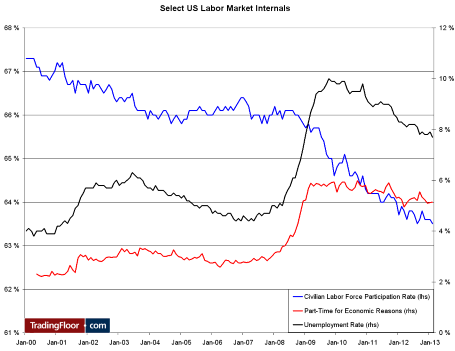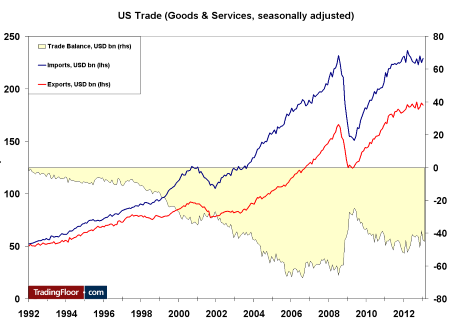The central bank-heavy week gets a break from policymakers with some real numbers for a change. In addition to the selected three items, Germany’s factory orders are worth mentioning.
Eurozone February Retail Sales (09:00 GMT): The expectation is for a drop of 0.2 percent after January’s surprisingly large 1.2 percent gain. In the final analysis, Europe has two choices: closer union or eventual breakup. Closer union requires political support at the national level but the electorate is becoming increasingly weary in many countries. This applies not just in austerity-ridden countries with mass unemployment, but also in creditor countries, where every quarter seems to come with a new bailout. Which is why it makes sense to keep a close eye on consumer behavior as a proxy for political support.
US March Employment Report (12:30 GMT): The consensus sees a solid addition of 200,000 non-farm jobs after a surprisingly high February reading of plus 236,000. Latest whisper/blogger numbers are somewhat lower, around 180-190,000. The unemployment rate is expected to remain unchanged at 7.7 percent. The macro data has been slightly disappointing lately and the payroll number could give the markets a negative surprise. Possible revisions to earlier months are very important to watch out for as markets are quick with arithmetic and a couple of revisions higher or lower can easily change the meaning of the current headline number.
The unemployment rate is currently trending lower nicely, but the 6.5 percent rate targeted by the Federal Reserve is still relatively far away and there is no immediate danger of a quick end to the central bank’s asset purchase programs. In a way, the macro situation is in a sweet spot for the risk-on crowd for now. But taking a look at the internals, the picture is not that pretty.
When the Great Recession started in 2008, the headline unemployment rate rose rapidly. With a small delay, the labour force participation rate started to drop: people simply stopped looking for work - they returned to education or retired. The participation rate is currently 2.5 percent lower than in 2007. Working part-time out of necessity became more prevalent as well, up from the pre-crisis level of three percent to five pecent.
This implies that the “true” unemployment rate is four to five percent higher than the official number. Even though the US is miles ahead of Europe, there is still plenty of catching up to do before the unemployment rate reaches six percent, the highest level seen in the aftermath of the dot-com bubble.
US February Trade Balance (12:30 GMT):The trade deficit is expected to remain almost unchanged at USD 45 billion against January’s 44.45 billion. Larger deficits are negative for the dollar, while smaller deficits are positive – usually. With the world economy being quite unstable at the moment, the breakdown of the trade numbers is of some interest. Trade growth and economic growth are usually correlated, so the absolute export and import levels are worth noting. International trade has basically remained at unchanged levels since early 2012, after a period of brisk growth following the 2009 global bottom. Most of the trade deficit is caused by imports from China and petroleum imports, and it is useful to look at the “pure” trade numbers excluding the volatile petroleum. While the trade deficit with Europe is a minor part of the total sum, it is worth watching because of the euro crisis – Europe is a major source of US corporate profits. 
- English (UK)
- English (India)
- English (Canada)
- English (Australia)
- English (South Africa)
- English (Philippines)
- English (Nigeria)
- Deutsch
- Español (España)
- Español (México)
- Français
- Italiano
- Nederlands
- Português (Portugal)
- Polski
- Português (Brasil)
- Русский
- Türkçe
- العربية
- Ελληνικά
- Svenska
- Suomi
- עברית
- 日本語
- 한국어
- 简体中文
- 繁體中文
- Bahasa Indonesia
- Bahasa Melayu
- ไทย
- Tiếng Việt
- हिंदी
EU Retail Sales, US Jobs And Trade Balance
Published 04/05/2013, 06:18 AM
Updated 03/19/2019, 04:00 AM
EU Retail Sales, US Jobs And Trade Balance
3rd party Ad. Not an offer or recommendation by Investing.com. See disclosure here or
remove ads
.
Latest comments
Install Our App
Risk Disclosure: Trading in financial instruments and/or cryptocurrencies involves high risks including the risk of losing some, or all, of your investment amount, and may not be suitable for all investors. Prices of cryptocurrencies are extremely volatile and may be affected by external factors such as financial, regulatory or political events. Trading on margin increases the financial risks.
Before deciding to trade in financial instrument or cryptocurrencies you should be fully informed of the risks and costs associated with trading the financial markets, carefully consider your investment objectives, level of experience, and risk appetite, and seek professional advice where needed.
Fusion Media would like to remind you that the data contained in this website is not necessarily real-time nor accurate. The data and prices on the website are not necessarily provided by any market or exchange, but may be provided by market makers, and so prices may not be accurate and may differ from the actual price at any given market, meaning prices are indicative and not appropriate for trading purposes. Fusion Media and any provider of the data contained in this website will not accept liability for any loss or damage as a result of your trading, or your reliance on the information contained within this website.
It is prohibited to use, store, reproduce, display, modify, transmit or distribute the data contained in this website without the explicit prior written permission of Fusion Media and/or the data provider. All intellectual property rights are reserved by the providers and/or the exchange providing the data contained in this website.
Fusion Media may be compensated by the advertisers that appear on the website, based on your interaction with the advertisements or advertisers.
Before deciding to trade in financial instrument or cryptocurrencies you should be fully informed of the risks and costs associated with trading the financial markets, carefully consider your investment objectives, level of experience, and risk appetite, and seek professional advice where needed.
Fusion Media would like to remind you that the data contained in this website is not necessarily real-time nor accurate. The data and prices on the website are not necessarily provided by any market or exchange, but may be provided by market makers, and so prices may not be accurate and may differ from the actual price at any given market, meaning prices are indicative and not appropriate for trading purposes. Fusion Media and any provider of the data contained in this website will not accept liability for any loss or damage as a result of your trading, or your reliance on the information contained within this website.
It is prohibited to use, store, reproduce, display, modify, transmit or distribute the data contained in this website without the explicit prior written permission of Fusion Media and/or the data provider. All intellectual property rights are reserved by the providers and/or the exchange providing the data contained in this website.
Fusion Media may be compensated by the advertisers that appear on the website, based on your interaction with the advertisements or advertisers.
© 2007-2024 - Fusion Media Limited. All Rights Reserved.
